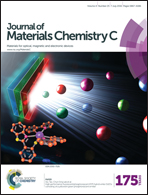Graphene induced porphyrin nano-aggregates for efficient electron transfer and photocurrent generation†
Abstract
Significant research attention has been given to graphene–porphyrin hybrid materials for light harvesting. In this report, we demonstrate the influence of graphene surface and aging time on the formation of porphyrin [5-(4-hydroxyphenyl)-10,15,20-triphenyl porphyrin (4-HPTP)] aggregates. The large sp2 conjugated network of reduced graphene oxide (RGO) may facilitate strong π–π stacking interactions that influence the aggregation of 4-HPTP. The morphologies of these assembled structures are characterized by field emission scanning electron microscopy (FE-SEM). Steady state and time resolved spectroscopic studies reveal that the formation of J-type aggregation of 4-HPTP on an RGO surface is higher than on a graphene oxide (GO) surface. In situ growth of porphyrin nanoassemblies on an RGO surface improves the electronic interaction by shortening the interfacial distance between graphene and porphyrin. It is evident that the electron transfer process is enhanced in the presence of RGO upon the photoexcitation of porphyrin nanoassemblies which eventually generate a photocurrent. These graphene decorated porphyrin nanoassemblies are promising materials for the development of new generation optoelectronic devices.


 Please wait while we load your content...
Please wait while we load your content...